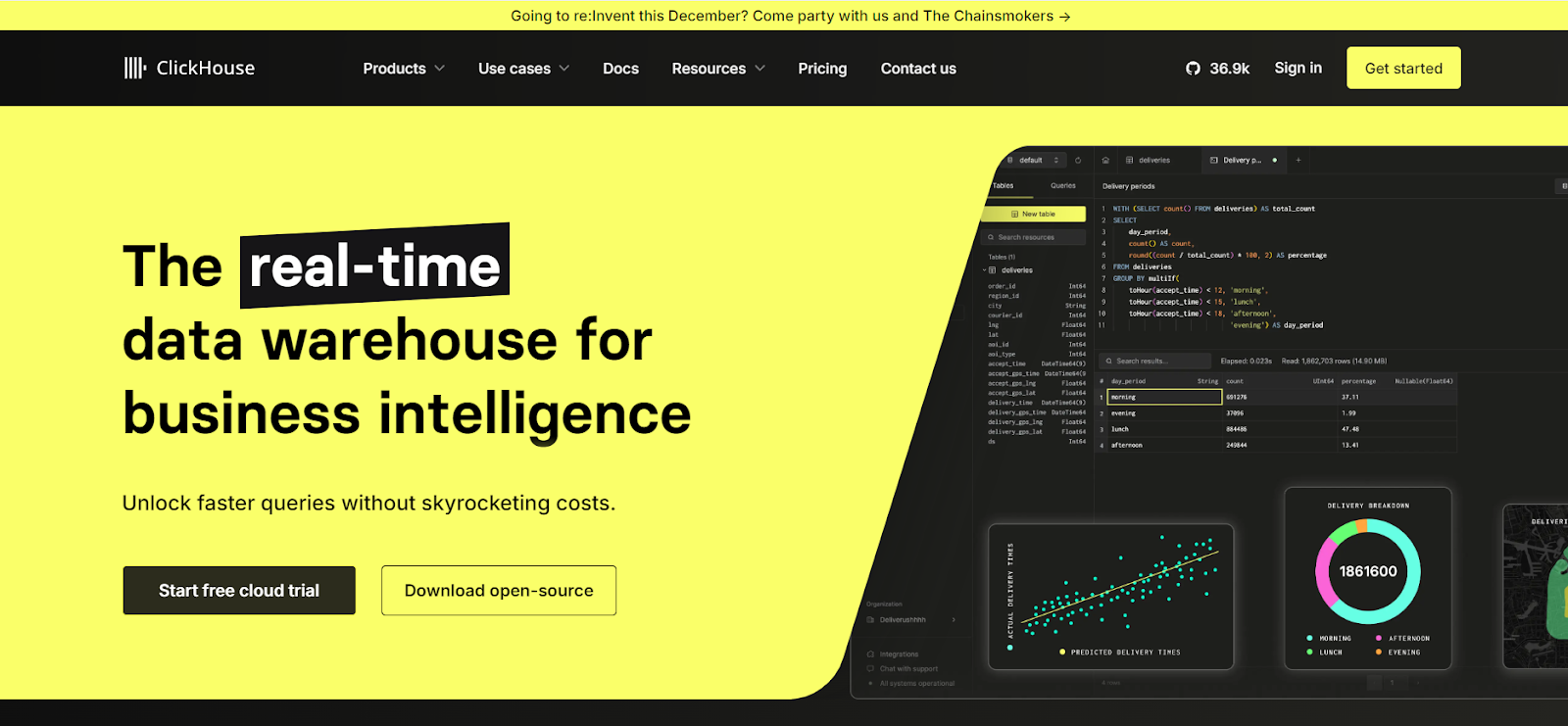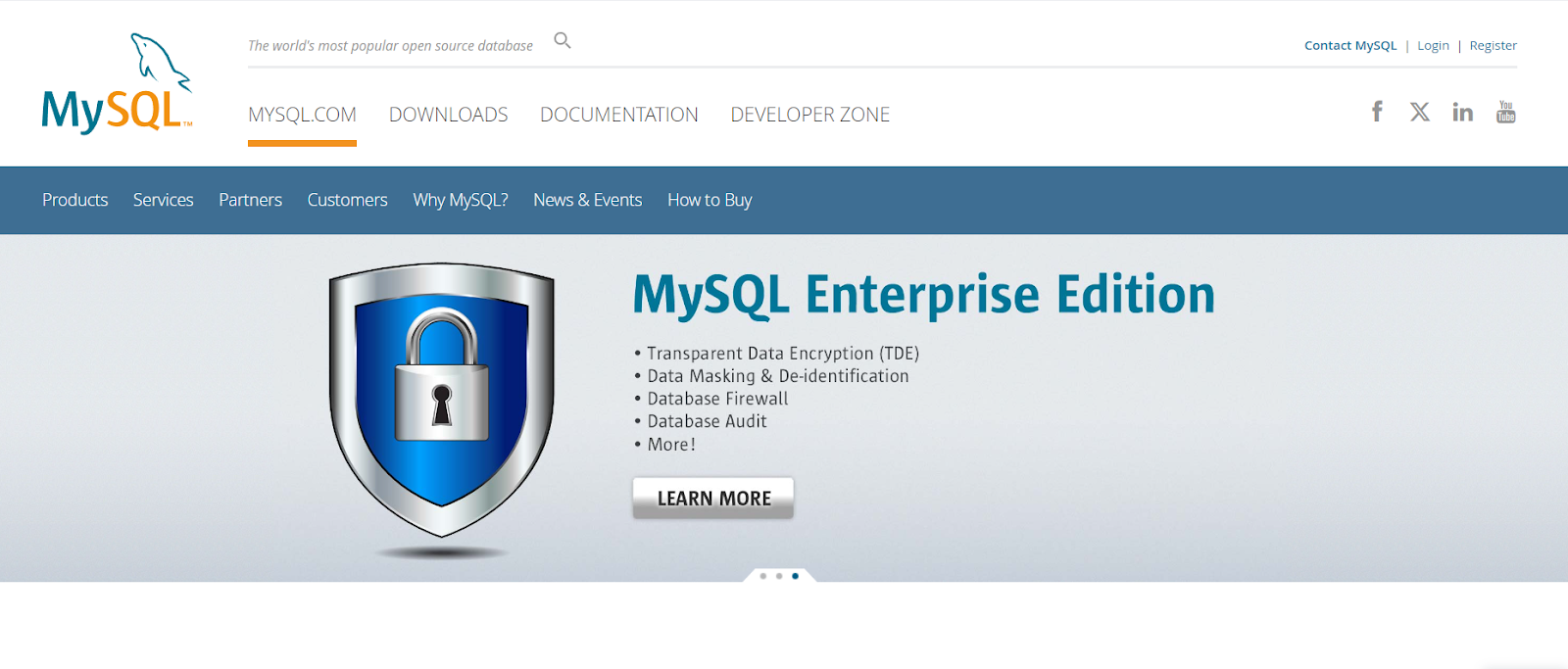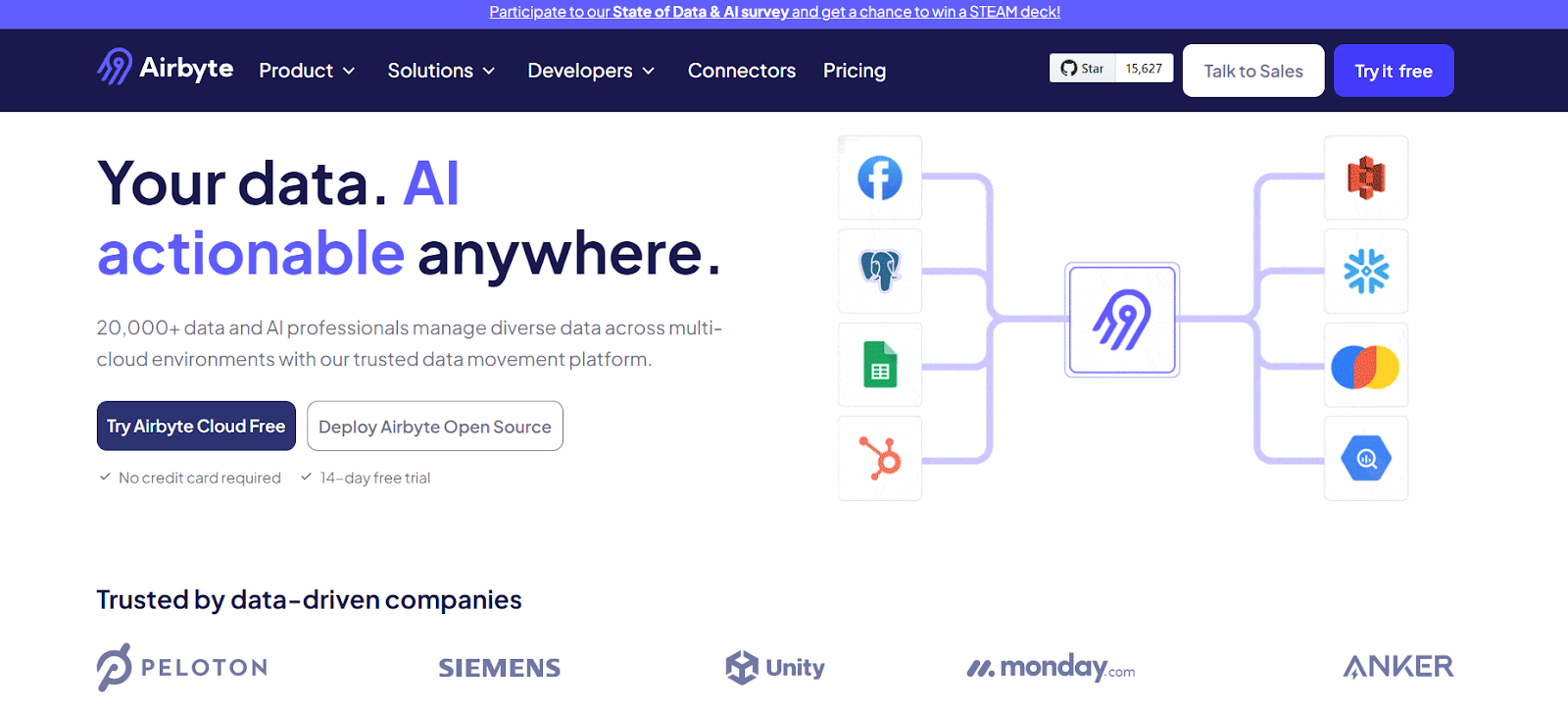Clickhouse Vs MySQL - Key Differences
Summarize this article with:
✨ AI Generated Summary
ClickHouse and MySQL serve distinct purposes: ClickHouse excels in high-speed, large-scale analytical (OLAP) workloads with columnar storage, advanced compression, and real-time analytics, while MySQL is optimized for transactional (OLTP) processing with ACID compliance and broad application compatibility. Effective integration often involves hybrid architectures using MySQL for transactional integrity and ClickHouse for analytics, facilitated by tools like Airbyte for seamless data synchronization and transformation.
- ClickHouse offers superior analytical query performance, scalability, and advanced features like vector search and materialized views.
- MySQL provides reliable transactional processing, extensive ecosystem support, and compatibility with LAMP stack applications.
- Hybrid approaches with CDC pipelines enable real-time data consistency and optimized workload distribution.
- Security, cost efficiency, and deployment flexibility are key factors guiding database selection based on specific organizational needs.
Data teams working with high-volume, high-velocity data face a critical decision that can determine their analytics success or failure. While ClickHouse processes faster than traditional databases for analytical workloads, MySQL continues to dominate transactional systems with unmatched reliability. Understanding when to leverage each database's strengths—and how to integrate them effectively—directly impacts your organization's ability to extract actionable insights from data while maintaining operational excellence.
This comparison examines the architectural differences, performance characteristics, and strategic considerations that determine whether ClickHouse or MySQL better serves your specific data requirements.
What Are OLTP and OLAP Processing Paradigms?
OLTP and OLAP represent two fundamental data-processing paradigms that serve distinctly different purposes in modern data architectures.
Online Transaction Processing (OLTP)
OLTP systems manage high-frequency, concurrent transactional workloads in real time. These systems optimize for high-speed, repetitive operations such as order processing, payment transactions, and customer interactions. OLTP databases prioritize data consistency, immediate response times, and concurrent user support while maintaining ACID compliance for transactional integrity.
Online Analytical Processing (OLAP)
OLAP enables complex, large-scale data analysis and reporting across massive datasets. These systems support multidimensional analysis through advanced operations like slicing, dicing, drill-downs, and roll-ups. OLAP databases help you explore data from multiple perspectives to uncover patterns and generate insights that drive strategic decision-making.
What Are the Core Characteristics of ClickHouse?

ClickHouse is an open-source columnar database management system specifically engineered for OLAP workloads and real-time analytical reporting. The system excels in low-latency query execution through vectorized processing and offers comprehensive data replication, sharding, and flexible deployment options across on-premises, bring-your-own-cloud, and public cloud environments.
Key Features of ClickHouse
- Auto-Scaling Capabilities: ClickHouse provides both vertical and horizontal scaling based on CPU and memory utilization patterns, automatically adjusting resources to match workload demands without manual intervention.
- Machine Learning and AI Integration: The platform simplifies data exploration, feature generation, and real-time analytics specifically designed for machine learning workflows, enabling seamless integration with AI-driven applications.
- Vector Search Functionality: ClickHouse combines vector similarity matching with metadata filtering and joins, scaling efficiently to support petabyte-sized vector databases for modern ML applications.
- Materialized Views: The system stores pre-calculated query results to deliver real-time insights and dramatically faster query response times for frequently accessed analytical data.
- Advanced Security Framework: ClickHouse includes multi-factor authentication, role-based access control, comprehensive encryption for data in transit and at rest, supported by a dedicated security team focused on enterprise-grade protection.
When to Use ClickHouse
- Log and Event Data Analysis: ClickHouse excels in real-time monitoring of application logs, distributed traces, and other time-series data streams that require immediate analytical processing.
- Data Warehousing Operations: The distributed architecture and massive storage capabilities support high-speed concurrent analytical workloads across multiple users and applications simultaneously.
- Business Intelligence Applications: ClickHouse integrates seamlessly with popular BI tools like Tableau, Looker, and Power BI to enable interactive analysis and dashboard creation for business users.
What Are the Core Characteristics of MySQL?

MySQL is an open-source relational database management system designed for OLTP scenarios requiring frequent data updates and rapid query responses. Beyond standard SQL support, MySQL works seamlessly with programming languages including PHP, Python, Java, and others. The platform supports diverse deployment models spanning on-premises infrastructure, private cloud environments, and fully managed cloud services.
Key Features of MySQL
- Enhanced Connectivity Options: MySQL supports multiple connection protocols, including TCP/IP, Unix domain sockets, Windows named pipes, and provides client libraries for numerous programming languages, ensuring broad application compatibility.
- Cross-Platform Portability: Built with CMake for comprehensive cross-platform compatibility, MySQL runs efficiently across macOS, Windows, Solaris, Linux, and other operating systems without modification.
- Geospatial Data Support: The platform includes OpenGIS spatial data types and specialized queries for location-based applications, mapping services, and geographic information systems.
- Event Scheduler Functionality: MySQL's built-in event scheduler automates database tasks and maintenance operations at specified times or intervals, reducing administrative overhead.
- Full-Text Search Capabilities: The database supports natural language searches, boolean search operations, and query expansion search types for comprehensive text-based data retrieval.
When to Use MySQL
- E-Commerce Applications: Popular platforms including WooCommerce, Shopify, and Magento rely on MySQL to store product catalogs, process orders, and manage customer transactions with high reliability.
- LAMP Stack Applications: MySQL serves as the core database component in LAMP stack architectures, combining Linux, Apache web server, MySQL database, and PHP/Perl/Python programming languages.
- Embedded Systems: The compact footprint and reliable performance make MySQL suitable for IoT devices, network routers, and other embedded systems requiring local data storage.
What Are the Key Architectural and Performance Differences?
The fundamental distinction between ClickHouse and MySQL centers on their architectural approaches to data storage and query processing. ClickHouse employs columnar storage optimized for high-performance analytics and large-scale data processing, while MySQL uses row-based relational storage designed for transactional processing and operational applications.
Data Storage Architecture
- ClickHouse Architecture: The columnar storage model stores data by columns rather than rows, enabling faster analytical queries through reduced I/O operations. This approach supports efficient compression algorithms that can achieve 4-10x compression ratios, significantly reducing storage costs and improving query performance for analytical workloads.
- MySQL Architecture: Row-oriented storage optimizes for transactional operations including inserts, updates, and deletes. MySQL supports multiple storage engines including InnoDB for ACID-compliant transactions, MyISAM for read-heavy workloads, and specialized engines for specific use cases.
ClickHouse vs MySQL Performance Comparison
- Analytical Query Performance: ClickHouse dramatically outperforms MySQL for analytical workloads through vectorized processing, SIMD instruction utilization, and parallel processing across distributed nodes. Complex aggregation queries that take minutes in MySQL often complete in milliseconds with ClickHouse.
- Transactional Performance: MySQL excels in transactional scenarios with optimized support for concurrent users, immediate consistency guarantees, and efficient handling of frequent updates. The platform's general-purpose design handles mixed workloads effectively, though limited parallelism can create bottlenecks under heavy concurrent analytical loads.
Indexing Strategies
- MySQL Indexing: Primarily utilizes B-tree indexes for efficient data retrieval, with specialized support for R-tree indexes for spatial data, hash indexes for Memory storage engine, and full-text indexes within InnoDB for text search operations.
- ClickHouse Indexing: Employs sparse primary indexes and data-skipping indexes that reduce disk I/O and memory overhead for analytical queries. This approach trades some point-query efficiency for dramatically improved performance on large-scale analytical operations.
Data Compression Capabilities
- ClickHouse Compression: Offers multiple compression codecs including LZ4, ZSTD, Delta encoding, and T64, providing flexible options for different data types and use cases. Advanced compression algorithms can reduce storage requirements by up to 90 percent compared to uncompressed data.
- MySQL Compression: InnoDB storage engine provides compression through the zlib library using LZ77 algorithms. While effective for reducing storage costs, MySQL offers fewer compression options and typically achieves lower compression ratios than ClickHouse.
Cost Considerations
Both platforms offer open-source editions with commercial support options. ClickHouse's superior compression and query efficiency can significantly reduce infrastructure costs for analytical workloads, while MySQL's mature ecosystem and widespread expertise may reduce operational expenses for transactional systems.
What Are the Recent Updates and Enhancements in ClickHouse and MySQL?
Recent developments in both databases reflect their distinct evolutionary paths, with ClickHouse focusing on advanced analytics capabilities and MySQL emphasizing stability and enterprise features.
ClickHouse Recent Innovations
- Lightweight Updates Revolution: ClickHouse introduced lightweight updates using patch parts that provide real-time visibility for data modifications without the traditional overhead of ALTER TABLE mutations. This advancement enables near-instantaneous updates in analytical workloads while maintaining the database's append-optimized architecture.
- Vector Similarity Index Advancement: The vector similarity index feature transitioned to beta status, enabling efficient similarity searches for machine learning applications, recommendation systems, and multimedia content analysis. This enhancement positions ClickHouse as a comprehensive platform for AI-driven analytics.
- Lakehouse Integration: Enhanced support for Iceberg tables through Hive metastore integration bridges open table formats with OLAP capabilities, allowing direct querying of data lake formats while maintaining compatibility with existing ClickHouse workflows.
- Single Consistent Snapshots: New shared storage snapshots across subqueries ensure atomicity in complex query execution, resolving potential consistency issues in multi-level analytical queries and improving data reliability.
MySQL Recent Enhancements
- GTID Group Names: MySQL introduced GTID group names for enhanced transaction management in multi-server replication topologies, simplifying batch assignment of transaction identifiers and improving workflow management for complex database clusters.
- Enhanced JSON EXPLAIN: Version 2 JSON formatting for EXPLAIN statements provides detailed access path information and cost estimates, laying groundwork for future machine learning integration in query optimization and improved performance analysis.
- Authentication Modernization: The deprecation of legacy mysqlnativepassword plugin pushes adoption of more secure authentication methods, improving overall security posture while requiring careful migration planning for legacy applications.
- Replication Resilience: Improvements to XCom communication through non-blocking SSL connections prevent indefinite hangs during node overload, directly enhancing availability in Group Replication deployments.
What Are the Best Practices for Data Integration When Using ClickHouse and MySQL?
Effective integration of ClickHouse and MySQL requires strategic approaches that leverage each database's strengths while addressing their respective limitations.
Hybrid Architecture Patterns
- Transactional-Analytical Separation: Deploy MySQL for operational workloads requiring ACID compliance while using ClickHouse for analytical processing. This pattern enables real-time transactional processing alongside high-performance analytics without compromising either workload's performance requirements.
- Change Data Capture Implementation: Implement CDC pipelines to capture real-time changes from MySQL binary logs and stream them to ClickHouse for analytical processing. This approach maintains data consistency across systems while enabling near-real-time analytics on transactional data.
- Data Lake Integration: Use ClickHouse's lakehouse capabilities to query data directly from object storage while maintaining MySQL for operational systems. This architecture reduces data movement overhead and enables flexible analytical processing across multiple data sources.
Performance Optimization Strategies
- Schema Design Alignment: Design ClickHouse schemas with columnar optimization in mind, using appropriate data types, partitioning strategies, and ordering keys that align with analytical query patterns. Simultaneously, optimize MySQL schemas for transactional efficiency with proper indexing and normalization.
- Query Workload Distribution: Route analytical queries to ClickHouse while maintaining operational queries in MySQL. This separation prevents analytical workloads from impacting transactional performance and ensures optimal resource utilization across both systems.
- Materialized View Strategies: Leverage ClickHouse materialized views for pre-computed aggregations while using MySQL for real-time operational data. This combination provides both immediate transactional capabilities and fast analytical insights.
Integration Technology Selection
- ETL vs ELT Considerations: Choose ELT patterns for large-scale data movement to ClickHouse, taking advantage of its processing capabilities, while using traditional ETL for smaller, more structured data movements to MySQL where transformation logic benefits from pre-processing.
- Streaming Integration: Implement streaming data pipelines for real-time synchronization between systems, particularly useful for maintaining analytical datasets in ClickHouse while processing transactions in MySQL.
How Does Airbyte Facilitate ClickHouse and MySQL Integration?
Airbyte provides a comprehensive data integration platform specifically designed to streamline connections between diverse database systems, including seamless integration between ClickHouse and MySQL environments.

Airbyte's open-source foundation combined with enterprise-grade capabilities makes it ideal for organizations seeking to implement hybrid architectures that leverage both ClickHouse's analytical power and MySQL's transactional reliability.
Key Integration Capabilities
- Pre-Built Connectors: Airbyte offers over 600 pre-built connectors, including optimized connectors for both ClickHouse and MySQL, eliminating the need for custom integration development and reducing time-to-deployment from months to weeks.
- Change Data Capture (CDC): Advanced CDC capabilities enable real-time synchronization between MySQL and ClickHouse, capturing incremental changes from MySQL binary logs and streaming them efficiently to ClickHouse for analytical processing.
- PyAirbyte Integration: The open-source Python library enables developers to build data-enabled applications that can seamlessly move data between ClickHouse, MySQL, and other systems including Snowflake, PostgreSQL, and DuckDB.
- Flexible Data Transformation: Integration with dbt Cloud and LLM frameworks supports complex data transformations, including RAG workflows and vector database loading, enabling sophisticated analytical pipelines across both database systems.
- Enterprise-Grade Security: End-to-end encryption, role-based access control, and comprehensive audit logging ensure secure data movement between systems while maintaining compliance with SOC 2, GDPR, and HIPAA requirements.
Deployment and Scaling Benefits
- Multi-Deployment Support: Whether you choose Airbyte Cloud for rapid setup, self-managed enterprise for complete control, or open-source for maximum customization, the platform adapts to your infrastructure requirements while maintaining consistent functionality.
- Production-Ready Performance: Airbyte processes over 2 petabytes of data daily across customer deployments, demonstrating the scalability needed for enterprise-grade ClickHouse and MySQL integration scenarios.
Learn more in the Airbyte documentation or connect with our sales team to explore integration strategies for your specific requirements.
What Should Guide Your Database Selection Decision?
The choice between ClickHouse and MySQL ultimately depends on your specific data management requirements, performance expectations, and architectural constraints.
Choose ClickHouse when you need:
- Real-time analytics and business intelligence on large datasets
- High-performance query processing with sub-second response times
- Efficient storage and processing of time-series or event data
- Scalable data warehousing with concurrent analytical workloads
- Advanced compression to minimize storage costs
Choose MySQL when you need:
- ACID-compliant transactional processing with immediate consistency
- Robust support for concurrent user operations and frequent updates
- Integration with existing LAMP stack or PHP-based applications
- Proven reliability for mission-critical operational systems
- Comprehensive ecosystem support and widespread expertise availability
Consider hybrid approaches when you need:
- Both transactional integrity and analytical performance
- Separation of operational and analytical workloads
- Gradual migration from legacy systems to modern analytics platforms
- Cost optimization through specialized database deployment
Evaluate your specific workloads, scalability requirements, compliance needs, and technical expertise to determine which approach best aligns with your organizational objectives and long-term data strategy.
Frequently Asked Questions
What is the main performance difference between ClickHouse and MySQL?
ClickHouse typically performs 100-1000x faster than MySQL for analytical queries due to its columnar storage and vectorized processing, while MySQL excels in transactional workloads requiring frequent updates and ACID compliance.
Can ClickHouse and MySQL be used together in the same architecture?
Yes, many organizations use hybrid architectures where MySQL handles transactional operations and ClickHouse processes analytical workloads, often connected through CDC pipelines or ETL processes for data synchronization.
Which database is more cost-effective for large-scale data operations?
ClickHouse generally offers better cost efficiency for analytical workloads due to superior compression ratios and query performance, while MySQL may be more cost-effective for transactional systems with its mature ecosystem and operational expertise.
How complex is it to migrate from MySQL to ClickHouse?
Migration complexity depends on your use case. For analytical workloads, tools like Airbyte can facilitate migration through automated pipelines, while transactional systems may require architectural changes to accommodate ClickHouse's append-optimized design.
What are the main security considerations when choosing between ClickHouse and MySQL?
Both databases offer enterprise-grade security features, but MySQL has a longer track record in regulated industries. ClickHouse provides modern security capabilitie,s including advanced encryption and RBAC, making both suitable for secure enterprise deployments.

.webp)
